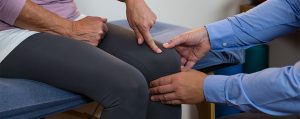How to Succeed in PT following ACL Reconstruction Surgery
“I don’t really have the words right now, definitely not the right ones at least,” this was the quote from Odell Beckham Jr. following his 2nd ACL tear during Superbowl LVI. Most people know that an ACL tear is a common knee injury that requires a long, tenacious recovery. Once an ACL is torn, the risk of re-tear or tearing the opposite side is 20-35% more likely4. The above statistic may be alarming and is why ACL reconstruction rehabilitation needs to be taken very seriously.
The Benefits of Work Conditioning Following Occupational Therapy
Completing an Occupational Therapy program for an upper extremity injury helps many individuals regain the skills and abilities to return to their jobs and daily activities. However, significant injuries will sometimes require additional time to improve endurance, strength, safety, and confidence to return to work. These select individuals may benefit from Work Conditioning, an individualized rehabilitation program created and overseen by a therapist and designed to help an injured worker cross the bridge between acute therapy and return to work.
3 Ways to Sleep Better with Shoulder Pain
The importance of sleep cannot be overstated. Recent research has discovered links between poor sleep and “hypertension, obesity, type-2 diabetes, impaired immune functioning, cardiovascular disease, arrhythmias, mood disorders, neurodegeneration and dementia, and even loneliness.” The causes for poor sleep are vast, but as it relates to physical therapy, sometimes pain can be the cause. Have you ever had a night you just can’t seem to get comfortable because your neck, back, or shoulder hurts? Next thing you know, the alarm clock is ringing, and you’ve barely slept at all. You drag through the next day at work, aren’t productive, and then go home only to experience the same poor night of rest again. Let’s look at ways to improve sleep that is disrupted due to shoulder pain. Sleep position is the most important piece when it comes to shoulder pain. An improved sleep position can truly make the difference maker between a restful and unrestful slumber. The following sleep position modifications may help provide additional support to the arm/shoulder to reduce pain.
What Is Hip Dysplasia?
Isn’t hip dysplasia something dogs have? The short answer is yes, but humans can also have hip dysplasia. Hip dysplasia has become increasingly more prevalent over the past decade, as hip dysfunction can be a source of pain. So, what is it? A typical presentation of hip dysplasia can be when the acetabulum (the portion of the hip joint attached to the pelvis) does not fully cover the femoral head (the hip joint’s ball). However, it may vary based on a variety of factors. Hip dysplasia can be diagnosed at birth, during childhood, or even as a young adult. Hip dysplasia is most common in females born from a first pregnancy and breech delivery.
How to Support a Family Member who Recently Had a Stroke
In medical terms, a stroke is a loss of blood flow to part of the brain, which damages brain tissue. This impairment can occur in any part of the brain, which can have numerous effects, ranging from vision, auditory, speech, hearing, swallowing, balance, emotional control and/or motor control. A stroke is one of the few “invisible” conditions that affect a person in various ways. Below you will find the top four things you can do to help your loved one through their recovery process.
5 Exercises to Relieve Knee Pain
In 2018, Bunt and his colleagues found “knee pain affects approximately 25% of adults, and its prevalence has increased almost 65% over the past 20 years, accounting for nearly 4 million primary care visits annually.”1 There are a number of causes for knee pain, and in many cases, physical therapy and exercise can help address the pain. Let’s take a look at five common exercises that can help reduce knee pain.
Chronic Pain May be Your Biggest Threat to a Good Night’s Sleep
Have you considered the link between your sleep and pain you may be experiencing? Recent research suggests that sleep and chronic pain are more closely linked than you might think. Not only does sleep deprivation affect your energy, concentration, and general health, it also can predict and even worsen your pain.
Tips for Relieving Jaw Pain
Temporomandibular Joint (TMJ) pain is common across all age groups and occupations. Whether you work at a computer, play contact sports, or are a world-renowned opera singer, the TMJ can be the source of much frustration. We use our jaw constantly throughout the day while talking, chewing, or trying to prop our head up on a Zoom call. Good jaw mechanics are essential.
